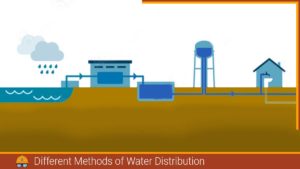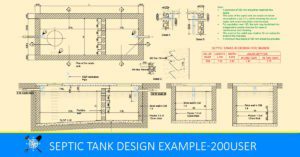Following the treatment process, water must be temporarily stored and then distributed to consumers via a network of pipelines known as the distribution system. This system encompasses pumps, reservoirs, pipe fittings, pressure measurement instruments, flow leak detectors, and other components. Approximately 40 to 70% of the total cost of the entire scheme is allocated to the distribution process. The effectiveness of the system relies on careful planning, execution, and maintenance. The ultimate goal is to consistently deliver potable water to all consumers whenever needed, ensuring an adequate quantity, appropriate pressure, minimal losses, and no leakage.
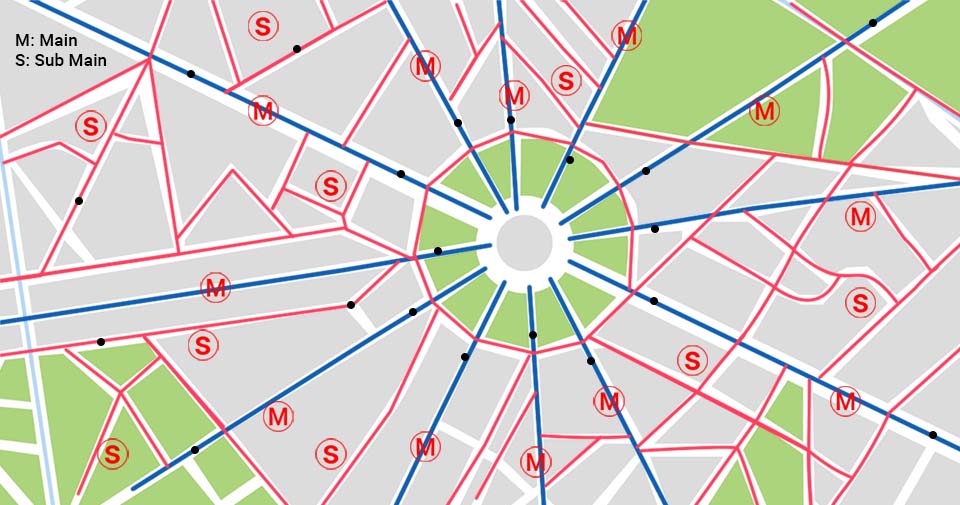
Requirement of A Distribution System:
- They should convey the treated water (water quality) upto consumers with the same degree of purity.
- The system should be economical and easy to maintain and operate.
- The diameter of pipes should be designed to meet the fire demand.
- It should be safe against any future pollution. As per as possible should not be laid below sewer lines.
- Water should be supplied without interruption even when repairs are undertaken.
- The system should be so designed that the supply should meet the maximum hourly demand. A peak factor of 2.5 is recommended for a town with a population of 0.5. to 2 lakhs. For a larger population, a factor of 2.0 will be adequate.
The layout of Distribution System:
In practical applications, there are typically four distinct distribution systems that are commonly employed. These systems include:
- Dead End or Tree system
- Grid Iron system
- Circular or Ring system
- Radial system
Dead End or Tree System
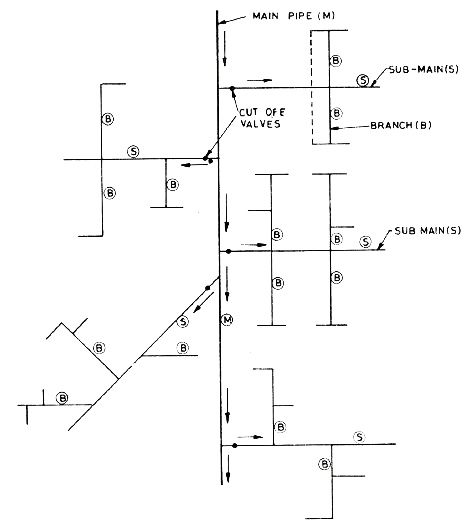
In this system, water flows in a single direction from a central source or supply point, branching out into multiple smaller pipelines that deliver water to individual consumers or sub-distribution points. The layout resembles the shape of a tree, with the main pipelines representing the trunk and the smaller pipelines acting as branches.
In the Dead End system, water flows from the central source through the main pipeline, and at certain points, smaller pipelines diverge to supply water to specific areas or consumers.
Advantages of Dead End System:
- The Dead End distribution system offers easy problem-solving capabilities, allowing for straightforward and accurate calculations of discharges and pressures at various points within the system. This facilitates efficient monitoring and maintenance of the network.
- Compared to other distribution systems, the Dead End system requires a lesser number of cut-off valves, simplifying the overall infrastructure. Additionally, the laying of pipes in this system is relatively easier, reducing installation complexities and associated costs.
- The Dead End distribution system is known for its cost-effectiveness and simplicity. It presents a cost-efficient solution that can be easily extended or expanded to accommodate growing demands or changes in the distribution network. This flexibility contributes to the adaptability of the system and makes it suitable for future expansion or modifications as needed.
Disadvantages of the Dead End System
- The Dead End System has certain drawbacks that should be considered. Firstly, since water can only reach specific points through a single route, any damage or repair in a pipeline will completely halt the water supply to the area served by that particular pipe. This can cause significant inconvenience to consumers if repairs or damages occur in main or sub-main pipes, impacting a considerable area.
- Additionally, the Dead End System features numerous dead ends, preventing the free circulation of water. This stagnant water can lead to a deterioration in water quality. To mitigate this, regular removal of stagnant water at all dead ends is necessary, requiring the installation of scour valves. However, this process results in significant wastage of treated water and demands careful monitoring and maintenance of each valve.
- Moreover, in the Dead End System, the water supply reaches a point from only one direction, limiting the ability to increase supplies during firefighting by diverting water from other sources. Consequently, this system provides only limited water supplies, which is a significant disadvantage for firefighting situations.
Grid Iron system
The Grid Iron system, also known as the Interlaced system, or Reticulation system, consists of interconnected pipelines forming a grid-like or loop pattern. The dead end of the Dead-End system or Tree system is interconnected with each other to form a Grid Iron system. In other words, the mains, sub-mains and branches are all interconnected with each other. This design enables water to flow in multiple directions, providing flexibility, redundancy, and continuous water supply even during disruptions or maintenance.
The Grid Iron system is particularly well-suited for towns or cities that have undergone meticulous urban planning, featuring a grid-iron pattern of roads that facilitates the seamless installation of pipelines. Its suitability is enhanced in well-planned urban areas where the alignment of pipelines can effortlessly follow the existing infrastructure, making it an optimal choice for such locations.
The interconnected pipelines reduce the impact of breaks or repairs by rerouting water through alternative pathways. This redundancy enhances reliability and minimizes service interruptions. The system is also adaptable to varying water demands, allowing adjustments in the flow direction to accommodate consumption patterns or shifts in demand.
Furthermore, the grid or loop system balances water pressure throughout the network. The interconnected pipelines enable water circulation in different directions, ensuring relatively consistent pressure levels. This benefits consumers located at the far ends of the distribution network, preventing lower pressure issues encountered in dead-end systems.
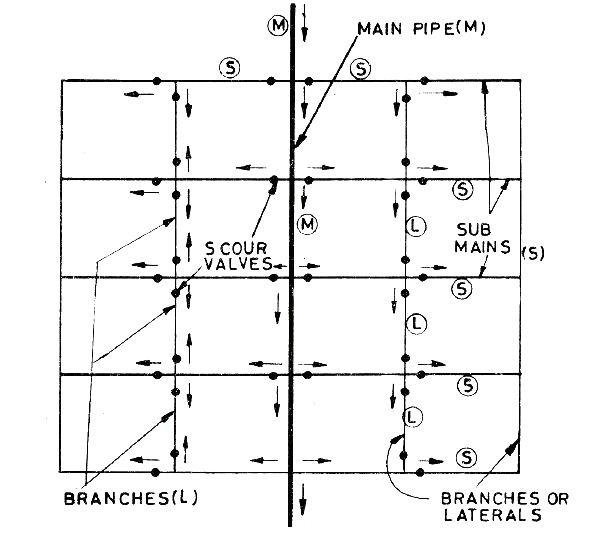
Advantages:
- The water flow in the Grid Iron or loop system operates continuously and without interruptions, ensuring a consistent and reliable water supply. This is due to the interconnected nature of the system, which eliminates stagnant areas where water could become trapped or stagnant.
- The interconnection of pipes in the Grid Iron system is crucial in minimizing head loss and ensuring efficient water movement throughout the distribution network.
- Certainly! Here’s an expanded version of that statement:
- One of the most important advantages of the Grid Iron system is the discharge capacity designed to meet the specific requirements for firefighting purposes, ensuring an ample supply of water with the necessary flow rate and pressure to effectively combat fires.
- Repair works can be conveniently carried out by closing the cutoff valve in the respective line, without impacting other users.
Disadvantages:
- The construction costs are higher due to the requirement of increased pipe length and a greater number of valves.
- Implementing a Grid Iron or loop system typically requires a higher initial investment compared to other distribution systems. The construction and installation of an interconnected network of pipelines, valves, and other components can be more complex and costly.
- Expanding or modifying a Grid Iron or loop system can be more challenging compared to simpler distribution systems. Adding new connections or extending the network requires careful planning to maintain hydraulic balance and ensure adequate water pressure throughout the system.
- The process of calculating pipe sizes and determining pressure levels at different points within the distribution system is a labour-intensive, complex, and challenging task.
Circular or Ring system
The Ring system is characterized by a circular or ring-shaped network of pipelines that form a closed ring, allowing water to flow in a continuous circular path. In this system, the branches are connected crosswise to the mains and each other.
In a Circular or Ring system, water flows in a single direction along the loop, typically in a clockwise or counterclockwise direction. The water enters the system from a single point, known as the inlet or source, and circulates through the interconnected pipelines, supplying water to the consumers connected to the network. The system is designed to maintain a continuous water flow, ensuring a reliable water supply throughout the distribution network.
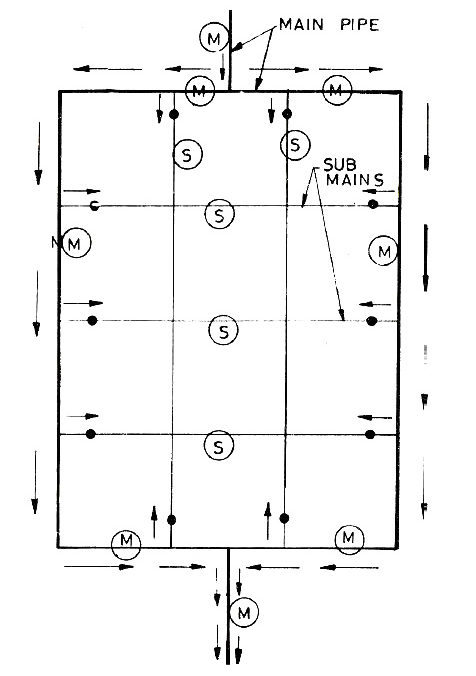
Radial system
If a city or town is having a system of radial roads emerging from different centres, the pipelines can be best laid in a radial method by placing the distribution reservoirs at these centres. In this system, water, is, therefore, taken from the water mains, and pumped into the distribution reservoirs placed at different centres. The water is then supplied through radially laid distribution pipes. This method ensures high pressures and efficient water distribution. The calculation for the design of size is also simple.
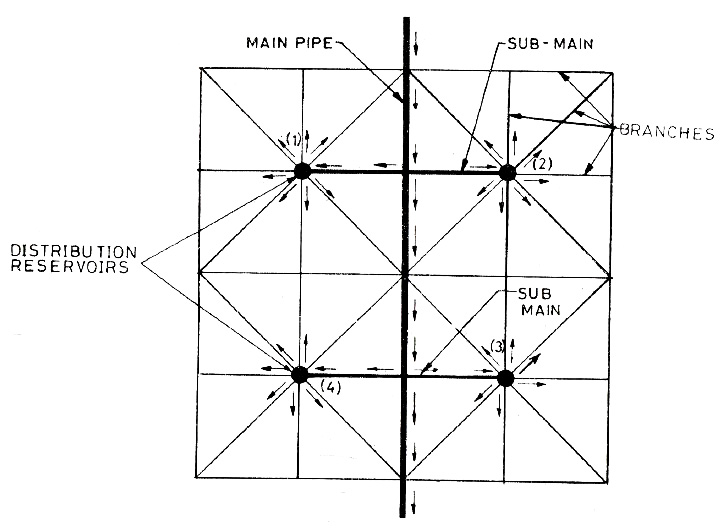
Advantages of Radial System
- This method ensures high pressures and efficient water distribution.
- Head loss is very small because of quick discharge.
- The calculation for the design of sizes is also simple.
Disadvantages
The initial cost of the project is high due to the need for individual distribution reservoirs.
References:
- Garg, S.K. (2010). Environmental Engineering. Vol.-I. Water Supply Engineering (35th ed.). Khanna Publishers. Daryaganj, New Delhi-110002.
- Punmia. B.C, Jain. A & Jain. A. (2005)Water Supply Engineering (2nd ed). Laxmi Publications (P) Ltd. New Delhi.
Also, read:
- Water Quality Parameters: Importance of Quality of Water?
- Cast Iron Pipe – Advantages and Disadvantages
- Per Capita Demand of Water | Factor Affecting Per Capita Demand
![]()





